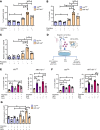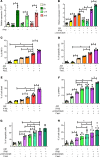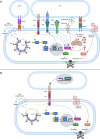The TLR7/IRF-5 axis sensitizes memory CD4+ T cells to Fas-mediated apoptosis during HIV-1 infection
- PMID: 37227774
- PMCID: PMC10371351
- DOI: 10.1172/jci.insight.167329
The TLR7/IRF-5 axis sensitizes memory CD4+ T cells to Fas-mediated apoptosis during HIV-1 infection
Abstract
HIV-1 infection is characterized by inflammation and a progressive decline in CD4+ T cell count. Despite treatment with antiretroviral therapy (ART), the majority of people living with HIV (PLWH) maintain residual levels of inflammation, a low degree of immune activation, and higher sensitivity to cell death in their memory CD4+ T cell compartment. To date, the mechanisms responsible for this high sensitivity remain elusive. We have identified the transcription factor IRF-5 to be involved in impairing the maintenance of murine CD4+ T cells during chronic infection. Here, we investigate whether IRF-5 also contributes to memory CD4+ T cell loss during HIV-1 infection. We show that TLR7 and IRF-5 were upregulated in memory CD4+ T cells from PLWH, when compared with naturally protected elite controllers and HIVfree participants. TLR7 was upstream of IRF-5, promoting Caspase 8 expression in CD4+ T cells from ART HIV-1+ but not from HIVfree donors. Interestingly, the TLR7/IRF-5 axis acted synergistically with the Fas/FasL pathway, suggesting that TLR7 and IRF-5 expression in ART HIV-1+ memory CD4+ T cells represents an imprint that predisposes cells to Fas-mediated apoptosis. This predisposition could be blocked using IRF-5 inhibitory peptides, suggesting IRF-5 blockade as a possible therapy to prevent memory CD4+ T cell loss in PLWH.
Keywords: AIDS/HIV; Apoptosis; Immunology; T cells.
Conflict of interest statement
Figures









Similar articles
-
IRF-5 Promotes Cell Death in CD4 T Cells during Chronic Infection.Cell Rep. 2018 Jul 31;24(5):1163-1175. doi: 10.1016/j.celrep.2018.06.107. Cell Rep. 2018. PMID: 30067973
-
Type I interferon upregulates Bak and contributes to T cell loss during human immunodeficiency virus (HIV) infection.PLoS Pathog. 2013;9(10):e1003658. doi: 10.1371/journal.ppat.1003658. Epub 2013 Oct 10. PLoS Pathog. 2013. PMID: 24130482 Free PMC article. Clinical Trial.
-
The Nef-mediated AIDS-like disease of CD4C/human immunodeficiency virus transgenic mice is associated with increased Fas/FasL expression on T cells and T-cell death but is not prevented in Fas-, FasL-, tumor necrosis factor receptor 1-, or interleukin-1beta-converting enzyme-deficient or Bcl2-expressing transgenic mice.J Virol. 2005 May;79(10):6377-91. doi: 10.1128/JVI.79.10.6377-6391.2005. J Virol. 2005. PMID: 15858021 Free PMC article.
-
The Hitchhiker Guide to CD4+ T-Cell Depletion in Lentiviral Infection. A Critical Review of the Dynamics of the CD4+ T Cells in SIV and HIV Infection.Front Immunol. 2021 Jul 21;12:695674. doi: 10.3389/fimmu.2021.695674. eCollection 2021. Front Immunol. 2021. PMID: 34367156 Free PMC article.
-
Adjunct Therapy for CD4+ T-Cell Recovery, Inflammation and Immune Activation in People Living With HIV: A Systematic Review and Meta-Analysis.Front Immunol. 2021 Feb 17;12:632119. doi: 10.3389/fimmu.2021.632119. eCollection 2021. Front Immunol. 2021. PMID: 33679779 Free PMC article.
Cited by
-
The multiple roles of interferon regulatory factor family in health and disease.Signal Transduct Target Ther. 2024 Oct 9;9(1):282. doi: 10.1038/s41392-024-01980-4. Signal Transduct Target Ther. 2024. PMID: 39384770 Free PMC article. Review.
-
Interferon regulatory factor 5: a potential target for therapeutic intervention in inflammatory diseases.Front Immunol. 2025 Mar 27;16:1535823. doi: 10.3389/fimmu.2025.1535823. eCollection 2025. Front Immunol. 2025. PMID: 40213550 Free PMC article. Review.
-
TLR7 signaling: a central nexus in autoimmunity and cGVHD.Blood Adv. 2024 Jun 25;8(12):3186-3188. doi: 10.1182/bloodadvances.2024012598. Blood Adv. 2024. PMID: 38696714 Free PMC article. No abstract available.
-
Transcription factor IRF-5 regulates lipid metabolism and mitochondrial function in murine CD8+ T-cells during viral infection.EMBO J. 2025 Aug;44(15):4280-4300. doi: 10.1038/s44318-025-00485-2. Epub 2025 Jun 10. EMBO J. 2025. PMID: 40494997 Free PMC article.
-
Restoration of LAT activity improves CAR T cell sensitivity and persistence in response to antigen-low acute lymphoblastic leukemia.Cancer Cell. 2025 Mar 10;43(3):482-502.e9. doi: 10.1016/j.ccell.2025.02.008. Cancer Cell. 2025. PMID: 40068599
References
Publication types
MeSH terms
Substances
Grants and funding
LinkOut - more resources
Full Text Sources
Medical
Molecular Biology Databases
Research Materials
Miscellaneous

